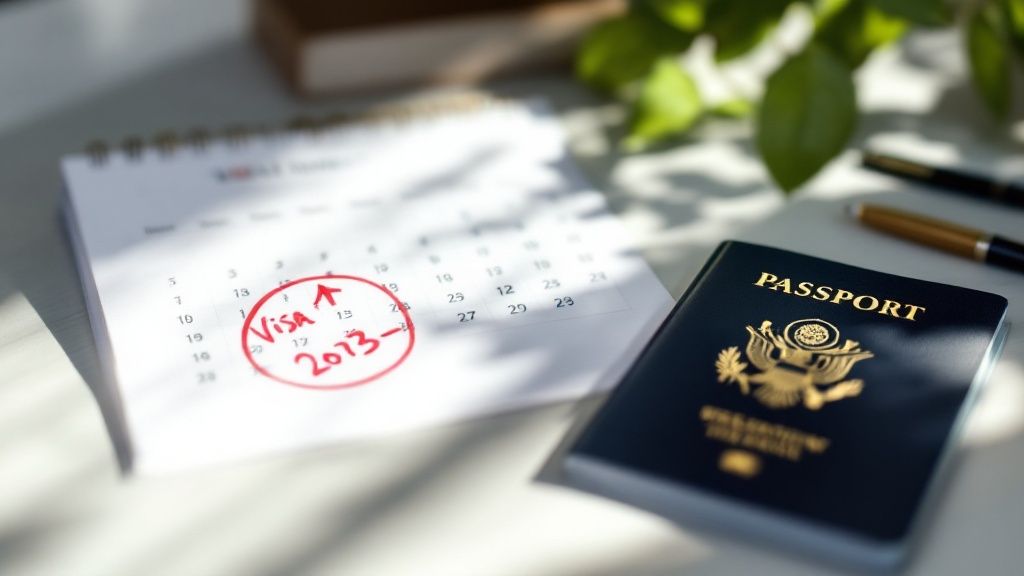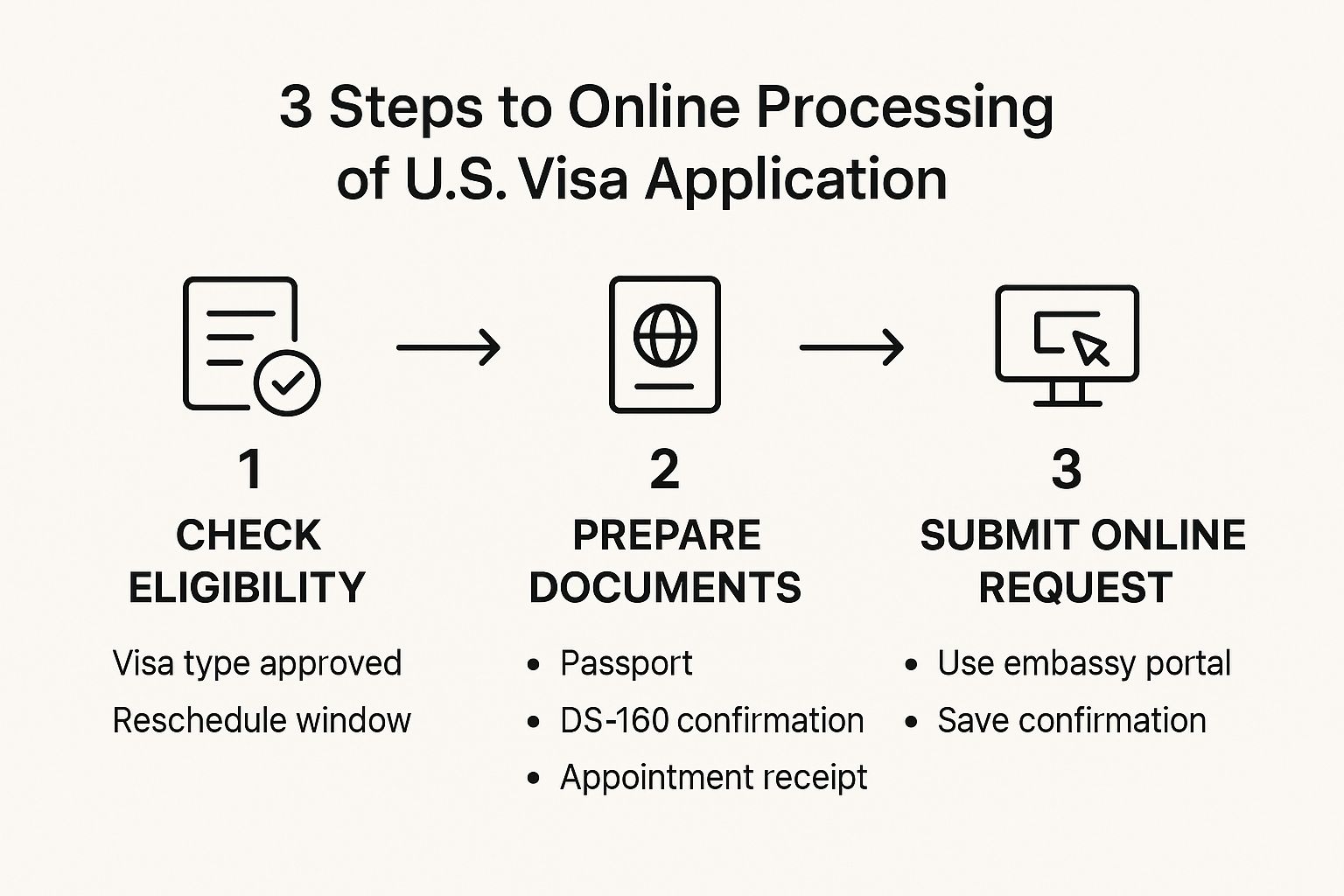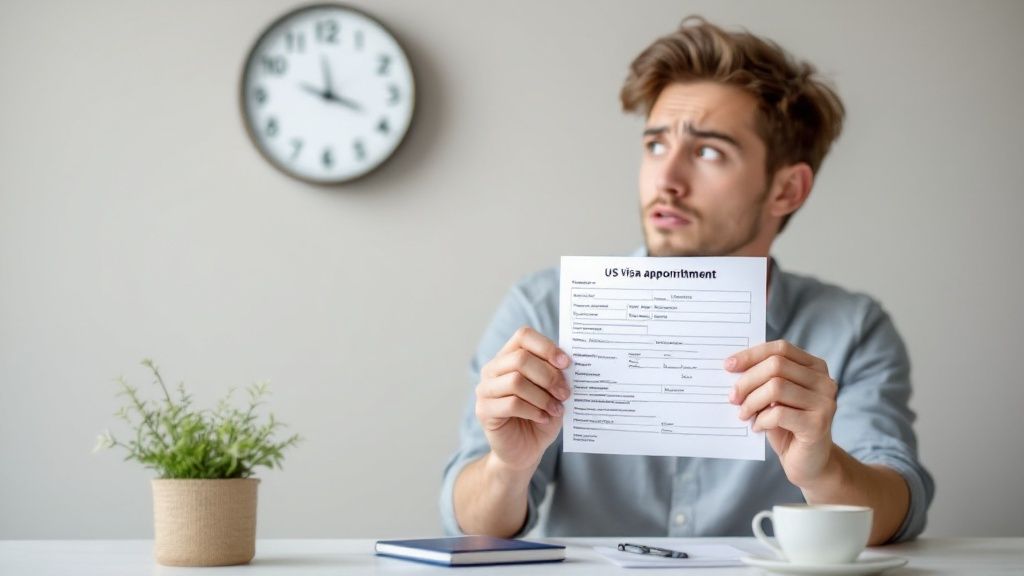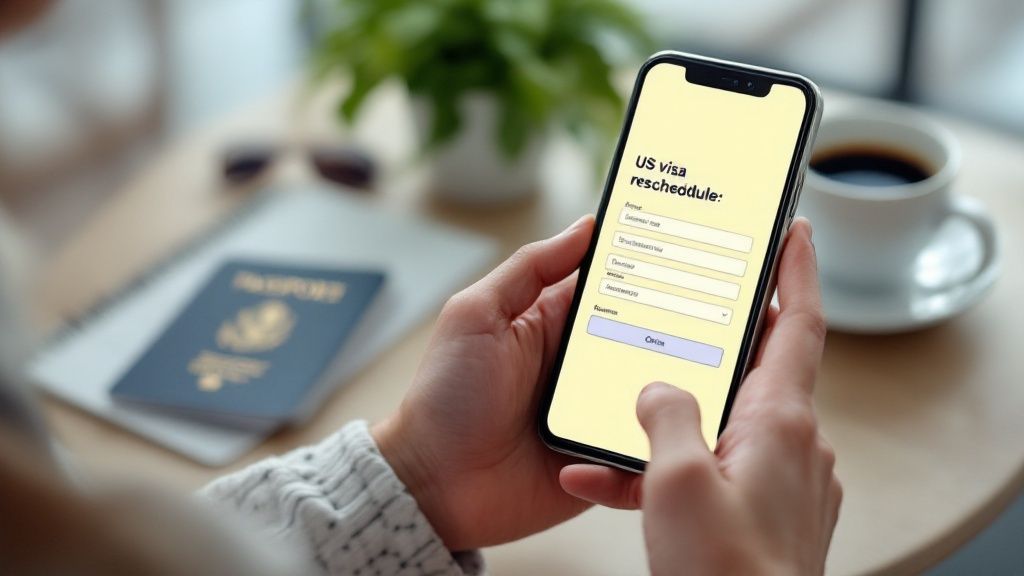Having to reschedule your US visa appointment is a lot more common than you might think. But navigating the official system to actually lock in a new date can be tricky, especially when available slots are scarce. The key is to work through the consular portal correctly, from logging in to finding your current appointment and then selecting the "reschedule" option.
I'll walk you through exactly how it's done so you can secure a new interview date without putting your application at risk.
Decoding the US Visa Reschedule Process
Changing your visa interview date can feel incredibly stressful. With wait times in some places stretching out for months—or even more than a year—the pressure is on to get it right.
But life happens. A sudden family emergency, an unavoidable conflict at work, or realizing you made a mistake on your DS-160 form after you’ve already booked are all perfectly valid reasons to need a new date.
The entire process is handled on the official U.S. government consular portal—the very same website you used to book your first interview. This online dashboard is where you’ll manage every detail of your appointment.
You'll start on the main login page for the Consular Electronic Application Center (CEAC). This is your gateway to managing your application and any scheduled appointments.

To get in, you'll need your application ID and a few other personal details to pull up your case file and see what your rescheduling options are.
Reschedule vs. Cancel: Making the Right Choice
One of the first things you need to be clear on is the difference between rescheduling and canceling. It’s a critical distinction. Rescheduling simply shifts your appointment to a new date while keeping your application and paid MRV fee active. Canceling, on the other hand, is a much bigger step. If you're not careful, it could mean forfeiting your fee and having to pay all over again.
Here’s a quick breakdown to help you decide which path is right for you.
Reschedule vs Cancel Key Differences
Action | Fee Status | Next Steps | Best For |
|---|---|---|---|
Reschedule | Your paid MRV fee remains valid and is applied to the new appointment date. | You search for a new available date within the portal. Your application stays active. | Applicants who still intend to get the visa but just need a different interview date. |
Cancel | You risk forfeiting the fee. The fee's validity period continues to run, and it might expire. | You must start a new application and potentially pay the fee again in the future. | Applicants who are abandoning their current visa attempt entirely. |
Choosing the right option from the start prevents a lot of headaches (and saves you money).
My Advice: Always, always choose to reschedule if you still plan on going through with your visa application. Only hit "cancel" if you’ve decided to completely abandon this visa attempt and understand you may have to pay the fee again later.
For many people, the biggest hurdle isn't figuring out how to reschedule; it's finding an open slot. This is where a specialized service can make a huge difference. At the moment, Vast Fisa supports only B1 and/or B2 visa applicants in select markets, including Canada, Colombia, Costa Rica, the Dominican Republic, Ecuador, Guatemala, Honduras, Mexico, Peru, Uganda, and Zambia. Using a tool like this can take the frustrating, time-consuming manual search off your plate.
But before you look into third-party help, it’s essential to get a handle on the basic rules of the consular system first.
Getting Around the Appointment Rescheduling Portal
Changing your US visa appointment all comes down to knowing your way around the official consular portal. Think of it as your mission control—everything from seeing your current date to locking in a new one happens here. You’ll start by logging into the same account you used for the initial booking, usually with your application ID and a password.
Once you’re in, you'll see your applicant dashboard. Take a look around and find your current appointment details. You should see a few options, but the one you're looking for is "Reschedule Appointment." Clicking that is the first real step.
Making Sense of the Appointment Calendar
After you hit the reschedule button, you’ll land on the calendar view. This is where most people get hit with a wave of panic. More often than not, the calendar will show absolutely nothing available for months, sometimes stretching well into the next year. It’s critical to remember that this calendar is constantly in flux; new slots pop up whenever other applicants cancel or change their own interviews.
The trick is not to get discouraged on your first, second, or even tenth try. Those rare open slots are often snapped up in seconds. This means you need a good dose of persistence and a smart strategy. If you want a refresher on the basics, much of the rescheduling process mirrors the initial booking, which we cover in our guide on booking a US visa appointment.
A classic rookie mistake is only checking the portal during normal business hours. The reality? Appointment slots can drop at any time—day or night—as the system processes cancellations from all over the world.
This infographic lays out the groundwork you need to cover before you even start clicking around online.

As you can see, a smooth reschedule starts with confirming you’re eligible and having every document ready to go. This prep work prevents frustrating errors once you’re logged in and racing against the clock.
Finding Those Elusive Open Slots
If you're trying to find a us visa reschedule appointment the old-fashioned way, timing is everything. From what we've seen and heard from countless applicants, a few tactics can genuinely boost your odds:
Check at odd hours. Seriously. Try logging in late at night or super early in the morning, based on the consulate's local time. System updates and cancellations often get processed when most people are asleep.
Keep an eye out after holidays. When people's travel plans fall through after a major holiday, you often see a surge in cancellations. The days right after a public holiday can be a goldmine for open slots.
Don't hesitate. If you see a date you can live with, book it. Immediately. If you pause for even a minute to think it over, someone else will grab it.
Locking in Your New Date (and What About the Fee?)
Once you manage to select a new date, you’re on the home stretch. The system will show you the new date and time and ask you to confirm. This is your last chance to back out.
One big question people have is about the fee. Don't worry—your original MRV fee is almost always valid for rescheduling. You shouldn't have to pay again unless you've hit the maximum number of reschedules the consulate allows.
After you confirm, a new appointment confirmation letter will be generated. You must download and print this new letter right away. Showing up with your old confirmation is a surefire way to be denied entry. Give the new document a thorough once-over to make sure your name, DS-160 number, and the new appointment details are all perfect.
Understanding the New Policies and Reschedule Limits
The ground rules for rescheduling a US visa appointment have changed in a big way, and what used to be a pretty flexible process now has some serious, costly catches. If you're thinking about moving your interview date, you absolutely need to get familiar with these new policies. A simple mistake could mean paying the entire visa fee all over again.

These changes didn't happen in a vacuum. They were rolled out to get a handle on the overwhelming demand and crazy-long wait times at many U.S. consulates. Gone are the days of shuffling your date around multiple times for free. Now, it's all about planning carefully from the start.
The New One-Reschedule Rule
The single biggest shift is the new limit on how many times you can reschedule for free. In a lot of high-demand countries, you now get just one single opportunity. That's it.
This policy is designed to cut down on the number of people who don't show up or change their plans at the last minute, which clogs up the whole system. For applicants in major hubs like India, for example, the US visa rescheduling policies were tightened to manage the surging demand. As of early this year, applicants there can only reschedule their appointment once for free, a massive drop from the three reschedules they were allowed before.
If you use that one free chance and find you need to change the date again, you’re out of luck. You'll have to pay the full visa application fee a second time and start the booking process from scratch. You can find more details about these updated visa rules on terratern.com.
Basically, your first attempt to reschedule is now your only shot to get it right without it costing you.
Why Your Documentation Details Are More Important Than Ever
Along with these new reschedule limits, consulates are being much stricter about documentation. I've seen people get turned away at the gate for a tiny mismatch between their forms. That now counts as a missed appointment, forcing a brand new, full-price booking.
Pay extra close attention to these details:
Matching DS-160 Numbers: The DS-160 confirmation number on your appointment letter must be an exact match for the barcode on the DS-160 confirmation page you bring with you. No exceptions.
Updating Your Profile: Did you submit a new DS-160 form after booking your original date? You have to log into the consular portal and update your profile with the new confirmation number before your interview day.
Printing the Correct Letter: This one is so simple but trips people up all the time. After you successfully reschedule, always download and print the newest appointment confirmation letter. Showing up with the old one is a guaranteed problem.
Key Takeaway: Treat your DS-160 confirmation number like your passport number. A mismatch isn’t seen as a small clerical error; it’s a critical failure that will stop you from even getting into your interview. This forces you to reschedule and, thanks to the new rules, will almost certainly cost you a new application fee. Plan carefully to avoid this expensive and completely preventable mistake.
Let’s be honest: trying to reschedule a US visa appointment by manually refreshing the consular portal is a miserable experience. It's a game of luck you're almost guaranteed to lose. You can waste hours glued to your screen, clicking endlessly, only to find no new dates—or worse, spot a perfect opening that disappears before you can even click on it.
There’s a much smarter way to tackle this.
Instead of parking yourself in front of a computer, services like Vast Fisa do the heavy lifting for you. We use technology to watch the consulate’s scheduling system around the clock, scanning 24/7 for those rare canceled appointments or newly released slots that pop up without warning.
This turns a mind-numbing manual task into a simple background process that works for you, even while you sleep. You can get back to your life, knowing you won’t miss out when that perfect, earlier date finally becomes available.
How Vast Fisa Grabs That Earlier Spot for You
We offer a couple of different ways to get you an earlier appointment, depending on how hands-on you want to be. You can get an immediate heads-up and book the date yourself, or you can let our system handle the entire thing for you.
Instant Alerts: You're in the Driver's Seat
Our Instant Alerts service is for people who want to stay in control of the booking process. The moment our system finds an open slot that fits your preferred date range, we send you an alert straight to your email. This gives you the critical advantage you need to log in and grab that appointment before anyone else even knows it's there.
Automatic Rescheduling: The "Set It and Forget It" Solution
If you'd rather not deal with the stress of racing to book a slot, our Automatic Rescheduling feature is the perfect solution. Just tell us your ideal dates, and our system takes over. The second a matching appointment opens up, it automatically reschedules it for you. This is the ultimate hands-off approach, ensuring you get the earliest possible date without lifting a finger.
For those with truly urgent travel needs, it's also worth looking into other official channels. We've put together a detailed guide on how to expedite a US visa appointment that covers those strategies.
Why speed matters: Those coveted early appointment slots don't last long. Seriously, we're talking less than 60 seconds before they're gone. An automated system can react and book faster than humanly possible, which dramatically boosts your odds of success.
To make it clearer, here's a simple breakdown of how the two services compare.
Vast Fisa Service Tiers
Feature | Instant Alerts | Automatic Rescheduling |
|---|---|---|
System Monitoring | 24/7 scanning | 24/7 scanning |
Notification | Immediate email alert | Confirmation after booking |
Your Action | You must log in and book | No action required from you |
Booking Speed | Depends on how fast you are | Instantaneous |
Best For | Control over the final booking | Maximum convenience and speed |
Ultimately, both options are designed to give you a massive advantage over manual refreshing.
It's important to know that currently, Vast Fisa is focused on helping B1 and/or B2 visa applicants in a specific set of countries. This allows us to deliver a really reliable service for the high-demand scheduling systems in Canada, Colombia, Costa Rica, the Dominican Republic, Ecuador, Guatemala, Honduras, Mexico, Peru, Uganda, and Zambia.
Navigating Common Rescheduling Headaches
Trying to reschedule a US visa appointment can feel like you're hitting a digital brick wall. The system is notoriously sensitive, and the cryptic error messages that pop up don't do much to lower your stress levels. Learning how to get around these common roadblocks is the key to successfully changing your date without losing your cool.

The good news is that most of these issues are just technical glitches. They're annoying, but you can usually fix them with a few simple tricks. The most important thing is not to panic and start clicking everywhere—that almost always makes things worse.
The Infamous "Maximum Views" Lockout
One of the most common—and infuriating—messages you'll encounter is, "You are approaching the maximum number of times you may view this page." This is the system's defense mechanism against bots and people like us who are constantly refreshing the page, hoping for a miracle.
If you see this warning, stop what you're doing immediately. Seriously. If you keep refreshing, you'll almost certainly get your account locked for anywhere from 24 to 72 hours.
Here’s what I’ve found works best:
Clear your browser's cache and cookies. This is the first thing to try, as it often clears up tracking data that triggers the error.
Log out and walk away. The safest move is to log out, close the browser entirely, and give it a full 24 hours before you even think about logging back in.
Go incognito for your next try. When you do log back in, use a private or incognito window. This gives you a completely fresh session, which can help avoid the issue.
Expert Insight: This error is a textbook case of manual refreshing burnout. It’s a huge risk because you could get locked out right when that perfect appointment slot finally opens up. This is exactly why an automated monitoring service is so valuable—it checks for slots 24/7 without tripping the system's security wires.
What if the Calendar Looks Completely Empty?
It’s a gut-punch to see a calendar with zero available dates for the next year. But don't despair; it doesn't mean no appointments exist. It almost always means that all the slots the consulate has released so far have been snatched up. This is especially true in high-demand countries where wait times are already sky-high.
For example, US visa appointment wait times have ballooned, particularly in India, where some applicants are looking at average delays of up to fourteen months. While Chennai has seen some relief with waits closer to three months, places like New Delhi can still take a full year. This got worse after new rules started requiring most people to apply from their home country, piling even more pressure on local consulates.
My MRV Fee is About to Expire! What Now?
Your MRV fee payment is only good for one year. If you're running out of time and still can't find an appointment, you have to be strategic.
Here's the trick: as long as you schedule any appointment before that fee expires—even if it's for a date far in the future—the validity of your fee gets extended. Once you have that appointment locked in, you can keep searching for an earlier date to reschedule to. The absolute key is to have a confirmed appointment on the books before that one-year clock runs out.
To make sure you're ready when a slot does open up, it helps to have all your documents in order. Our comprehensive B-2 visa documents checklist is a fantastic resource for getting everything organized ahead of time.
Common Questions About Rescheduling Your Visa Appointment
Going through the US visa process can feel like a maze, and when you have to reschedule, a whole new set of questions pops up. It's easy to get overwhelmed, but getting the right answers is crucial. A simple mistake here could cost you time and money.
Let's clear up some of the most common concerns people have when they need to change their appointment date.
How Many Times Can I Reschedule?
This is the big one, and the rules have gotten tighter recently. For most applicants, you get one free reschedule. That’s it. Think of it as your one and only mulligan.
This isn't just a suggestion; it's a firm policy at most consulates trying to work through a massive number of applications. If you use up your free reschedule and find you need to change the date again, you'll almost certainly have to pay the entire visa application (MRV) fee a second time. So, make that first change count.
Will Rescheduling Hurt My Chances of Getting the Visa?
Let’s put this myth to rest: absolutely not. Rescheduling an appointment has zero impact on whether your visa gets approved. Consular officers know that life happens—emergencies come up, plans change. They don't hold it against you.
Your visa application is judged on its own merits: your documents, your interview performance, and your ties to your home country. The only real downside to rescheduling is the potential for a much longer wait for the next open slot, not a mark against your name.
What if My DS-160 Number Is Wrong?
This is a detail you absolutely cannot overlook. The DS-160 confirmation number on your appointment letter must be an exact match to the DS-160 confirmation page you bring with you to the interview. If they don't match, you will be turned away at the door. No exceptions.
Did you fill out a new DS-160 form after you booked your initial appointment? That's fine, but you have one critical step to take. You must log back into your consular account and update your profile with the new DS-160 confirmation number before you go. If you forget, you'll miss your slot and be forced to reschedule.
A unified US policy for nonimmigrant visa rescheduling states that applicants are allowed only one free reschedule per appointment. A second change requires a new visa fee. This policy also reinforces that the DS-160 confirmation page presented at the interview must match what's on file for that specific appointment. These rules are in place for a wide range of travelers, making careful planning more important than ever. You can find more details about these nonimmigrant visa policies on ogletree.com.
Tired of staring at the consulate calendar, hitting refresh, and hoping for a miracle? Vast Fisa takes the stress out of the equation. We monitor the appointment system 24/7 and can either book an earlier slot for you automatically or send you an instant alert the second one opens up.
Stop waiting and start planning. See how it works at https://www.vastfisa.com today.
